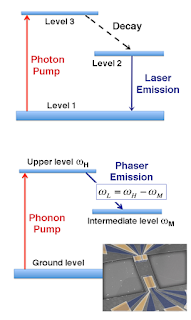The theoretical foundations for the laser were established in 1917, when Einstein formulated the quantum theory of radiation, describing the absorption, spontaneous emission, and stimulated emission of electromagnetic radiation. Its realization stayed hidden for decades, however, before it emerged in the form of masers and lasers, which emit microwave and visible radiation, respectively. The range of emitted frequencies was soon broadened to cover wavelengths from the infrared to the x-ray range, and lasing was extrapolated beyond the realm of optics. Free-electron lasers, in which the active medium is a relativistic electron beam, helped cover extreme wavelength ranges and are now the basis for a new generation of experimental facilities for x-ray experiments. Atom lasers—emitting matter waves instead of photons—have also been demonstrated. Recently, the laser idea was extended to sound waves, leading to the conceptualization of the acoustic analog of a laser, which emits phonons (lattice vibrations) instead of photons. Now, writing in Physical Review Letters, Imran Mahboob at the NTT Basic Research Laboratories, Japan, and colleagues report on the experimental demonstration of a purely mechanical counterpart of a three-level laser scheme [1]. The device, excited by acoustic vibrations, amplifies sound waves through stimulated emission of phonons and acts as a phonon laser: a spectrally pure source of phonons with a frequency of around 1.7 megahertz (MHz).
What is the appeal of phonon lasers? One potential advantage is that their emission has smaller wavelength than that of photon lasers at the same frequency because the sound speed is much smaller than the speed of light. This could help improve the resolution of tomographic, ultrasound, and other imaging techniques. In analogy with their optical cousins, phonon lasers might deliver directional and coherent acoustic beams, which could be coupled to nanoscale mechanical engines or used in communication networks based on acoustic waves. But as the history of optical lasers suggests, most applications of future phonon lasers may be completely unexpected.
The Trekkie in me notes: from the phonon pump, the upper-to-intermediate level transition is called "Phaser Emission." Wonder if there's a stun setting?
American Physical Society: Lasers of Pure Sound

Comments